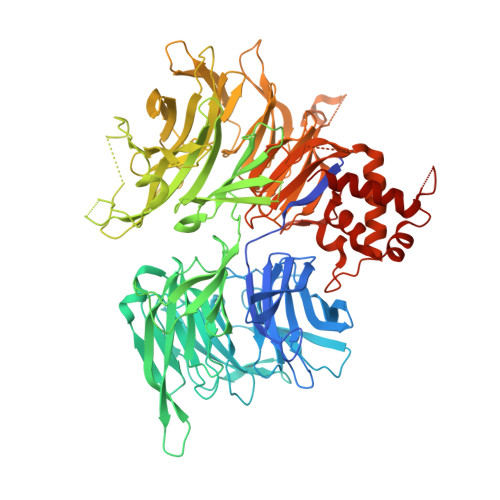Targeting DCAF5 suppresses SMARCB1-mutant cancer by stabilizing SWI/SNF.
Radko-Juettner, S., Yue, H., Myers, J.A., Carter, R.D., Robertson, A.N., Mittal, P., Zhu, Z., Hansen, B.S., Donovan, K.A., Hunkeler, M., Rosikiewicz, W., Wu, Z., McReynolds, M.G., Roy Burman, S.S., Schmoker, A.M., Mageed, N., Brown, S.A., Mobley, R.J., Partridge, J.F., Stewart, E.A., Pruett-Miller, S.M., Nabet, B., Peng, J., Gray, N.S., Fischer, E.S., Roberts, C.W.M.(2024) Nature 628: 442-449
- PubMed: 38538798
- DOI: https://doi.org/10.1038/s41586-024-07250-1
- Primary Citation of Related Structures:
8TL6 - PubMed Abstract:
Whereas oncogenes can potentially be inhibited with small molecules, the loss of tumour suppressors is more common and is problematic because the tumour-suppressor proteins are no longer present to be targeted. Notable examples include SMARCB1-mutant cancers, which are highly lethal malignancies driven by the inactivation of a subunit of SWI/SNF (also known as BAF) chromatin-remodelling complexes. Here, to generate mechanistic insights into the consequences of SMARCB1 mutation and to identify vulnerabilities, we contributed 14 SMARCB1-mutant cell lines to a near genome-wide CRISPR screen as part of the Cancer Dependency Map Project 1-3 . We report that the little-studied gene DDB1-CUL4-associated factor 5 (DCAF5) is required for the survival of SMARCB1-mutant cancers. We show that DCAF5 has a quality-control function for SWI/SNF complexes and promotes the degradation of incompletely assembled SWI/SNF complexes in the absence of SMARCB1. After depletion of DCAF5, SMARCB1-deficient SWI/SNF complexes reaccumulate, bind to target loci and restore SWI/SNF-mediated gene expression to levels that are sufficient to reverse the cancer state, including in vivo. Consequently, cancer results not from the loss of SMARCB1 function per se, but rather from DCAF5-mediated degradation of SWI/SNF complexes. These data indicate that therapeutic targeting of ubiquitin-mediated quality-control factors may effectively reverse the malignant state of some cancers driven by disruption of tumour suppressor complexes.
- Division of Molecular Oncology, Department of Oncology, St Jude Children's Research Hospital, Memphis, TN, USA.
Organizational Affiliation:


















